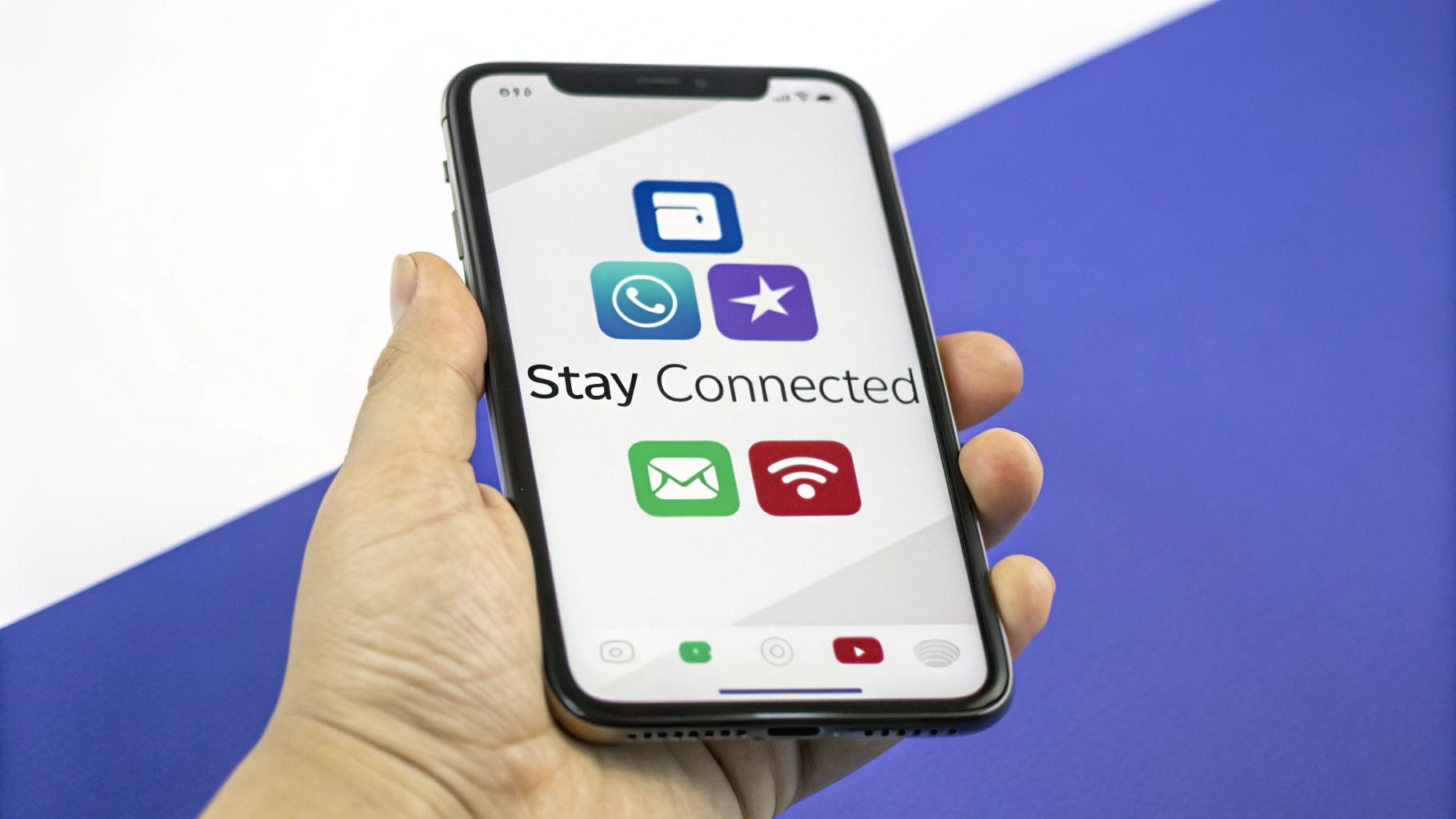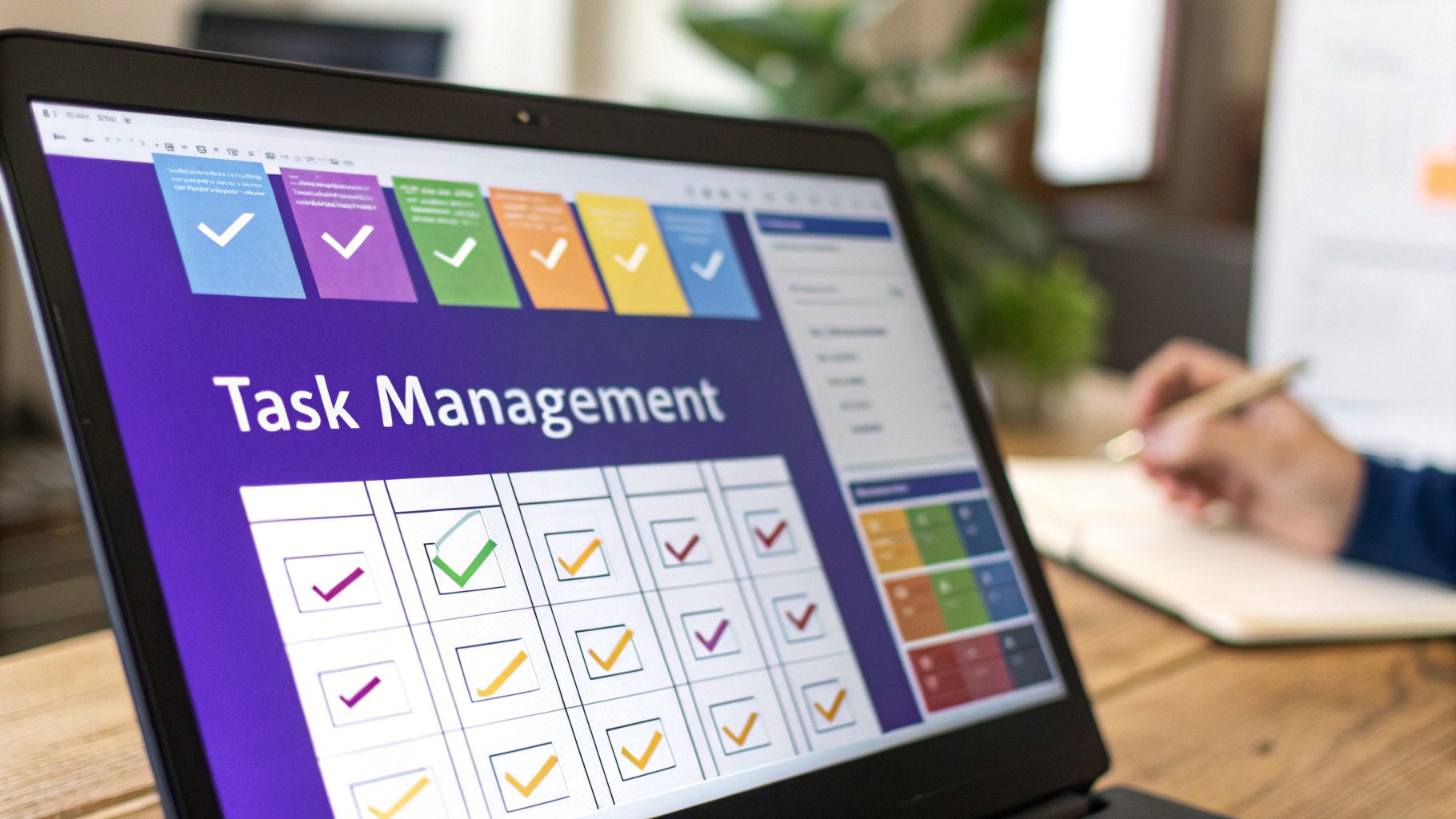10 Best Tools for Remote Teams: A Step-by-Step Guide to Virtual Excellence
Building Your Remote Team's Digital Foundation

The success of a remote team depends heavily on having the right digital tools in place. Through conversations with successful remote companies, we've learned that choosing and setting up the right tools creates the foundation for effective collaboration and strong team connections, even when team members are physically far apart.
Essential Tools For A Productive Remote Environment
Leading remote teams know that basic video calls aren't enough - they need tools that enable real-time document editing, smooth project tracking, and meaningful virtual team activities. When teams select tools thoughtfully, they can create an environment where remote work feels natural and engaging.
Many teams struggle when different departments use disconnected tools. That's why successful remote companies focus on finding integrated platforms that bring workflows and communication together in one place. Just as you wouldn't build a house using different blueprints for each room, your team needs a unified set of tools that keeps everyone aligned and working efficiently.
Choosing The Right Tools: A Practical Framework
Here's a straightforward approach to selecting tools that fit your team's specific needs:
- Identify Core Needs: List out your essential requirements - whether that's project management capabilities, real-time chat, or a central knowledge hub
- Prioritize Integration: Select tools that work well together to minimize switching between apps
- Consider User Experience: Choose intuitive tools that team members can start using quickly
- Evaluate Scalability: Pick tools that can grow alongside your team without major disruptions
Real-World Examples of Successful Tool Adoption
The impact of choosing the right tools shows up clearly in real team results. Some teams report completing 30% more projects after implementing proper project management software. Others have cut email volume in half by adopting team chat platforms, giving people more time to focus on important work.
Tools like Notion for documentation and Basecamp for project coordination consistently help remote teams work better together. The key is viewing these tools not as expenses, but as investments in your team's ability to collaborate and succeed. You might be interested in: Proven Virtual Team Building Activities to Transform Remote Teams. This highlights how the right tools do more than just enable work - they help build a positive remote team culture.
Mastering Virtual Communication Platforms
Good communication is essential for remote teams to succeed. While basic video calls are important, the most effective remote teams use multiple communication tools strategically to build real connections and work together smoothly. Let's explore how to get the most out of these tools.
Beyond the Basics: Unlocking Advanced Communication Features
Most teams only scratch the surface of what their communication platforms can do. Take AI meeting transcriptions - this often-overlooked feature creates searchable records that save time and keep everyone informed. For instance, you can quickly find specific discussion points from past meetings without replaying entire recordings. This helps teams work efficiently across different time zones and locations. Many platforms also include team building features that help people connect beyond just work tasks, creating stronger bonds between team members.
Creating Engaging Virtual Spaces
The best remote organizations design virtual spaces that recreate the natural interactions you'd have in a physical office. Think of it like planning an office layout - instead of physical break rooms and hallways, you create dedicated channels for different projects, casual chats, and virtual "water cooler" conversations. These spaces make it easy for team members to communicate naturally and build relationships in a relaxed way. This helps prevent isolation and builds a strong team culture. Learn more in our article about How to master inter-team communication.
The Power of Integration: A Seamless Collaboration Experience
For communication tools to work well together, they need to be properly integrated. Like musicians in an orchestra, each tool should play its part while working harmoniously with the others. When instant messaging for quick questions, video calls for detailed discussions, and project management tools for task tracking all work together smoothly, teams can collaborate without friction. This prevents the frustration of constantly switching between disconnected apps and helps everyone stay focused.
Best Practices for Choosing Communication Platforms
Picking the right communication tools is crucial for remote team success. Start by understanding what your team specifically needs - do you mainly need robust video conferencing for large meetings, or is quick messaging and file sharing more important? Then consider how well tools integrate with your other software. Most importantly, choose tools that are simple to use, since complicated platforms discourage adoption and engagement.
| Feature | Benefit | Example Tools |
|---|---|---|
| Video Conferencing | Face-to-face interaction, fostering connection and clarity | Zoom, Google Meet, Microsoft Teams |
| Instant Messaging | Quick communication, ideal for clarifying questions and sharing updates | Slack, Microsoft Teams |
| File Sharing | Seamless collaboration on documents and other files | Google Drive, Dropbox |
| Meeting Transcription | Searchable records of discussions, aiding accessibility and knowledge sharing | Otter.ai, Zoom (built-in feature) |
| Virtual Team Building | Fostering team cohesion and morale through structured online activities | Gatheround, TeamCheck |
The best remote teams excel by carefully choosing and using their communication tools. When teams fully use advanced features, integrate tools effectively, and focus on engagement, they build strong relationships and achieve great results no matter where team members are located. You might be interested in: How to master inter-team communication.
Project Management Tools That Actually Drive Results

Strong communication is essential for remote teams, but without well-organized project management, even teams that communicate well can struggle to deliver results. The right project management tools act as the foundation that coordinates work and keeps everyone moving toward common goals.
Choosing the Right Project Management Platform for Your Team
Finding the right project management tool starts with understanding what your specific team needs. For smaller teams with straightforward projects, a simple visual tool like Trello can work great for managing workflows on Kanban boards. But when handling complex projects with many moving parts, larger teams often do better with robust platforms like Asana or Jira that offer advanced features such as Gantt charts and dependency tracking. This helps ensure your team has the right level of functionality - not too complex, not too basic.
Breaking Down Projects and Setting Milestones
Good project management requires breaking large initiatives into manageable pieces, similar to working on a puzzle one section at a time. Start by dividing big projects into smaller tasks that teams can reasonably tackle. Then set clear milestone markers to celebrate progress points along the way. These milestones help maintain motivation and give teams a sense of forward progress, making even complex projects feel achievable.
Maintaining Alignment Without Micromanagement
While some worry that remote project management leads to micromanagement, the right tools actually promote independence while keeping everyone aligned. Platforms like Monday.com and Basecamp provide central dashboards showing project status, deadlines and responsibilities. This transparency means managers don't need constant check-ins since everyone can see progress. Features like automated reports keep teams informed without requiring excessive oversight.
Customizing Your Tools for Optimal Workflow
Getting the most from project management tools requires customizing them to match how your team works best. Most platforms let you adjust workflows, notifications, integrations and task assignments to fit your needs. For example, you can connect your project tool to your team chat platform so new tasks automatically trigger notifications. This creates smooth information flow between systems. Taking time to customize your tools helps build an organized workspace that supports productive collaboration. With the right setup, project management tools become powerful assets for remote team success.
Time Management Solutions That Respect Your Team
Managing time effectively is essential for remote teams to thrive, but it requires finding the right balance between tracking progress and maintaining trust. The key is to use time management tools as enablers rather than surveillance - resources that help individuals work better while strengthening the entire team.
Choosing the Right Tools for the Job
The best time management tools match your team's specific needs and work style. For teams billing clients hourly, detailed tracking software like Toggl Track or Clockify provides precise logging that integrates with project systems. But teams with flexible schedules may only need basic tools like Google Calendar or shared calendars in Asana to coordinate. Pick tools that support rather than restrict how your team works best.
Fostering Trust and Transparency
Success with time management tools depends on building trust through clear communication. Be upfront about why you're using these tools - frame them as resources for improving productivity, planning projects, and balancing workloads, not monitoring behavior. For example, time data can identify workflow bottlenecks or ensure no one gets overloaded. Get the team involved in choosing tools so they feel ownership and know the tools serve their needs.
Setting Healthy Boundaries and Preventing Burnout
When used thoughtfully, time management tools help prevent burnout in remote teams. Features like time-off tracking in BambooHR or vacation scheduling in Google Workspace make it simple for team members to plan breaks. This reinforces work-life balance, which is crucial for long-term success. The data can also reveal concerning patterns, like consistently long hours, so you can provide support early. See our guide on preventing burnout for proven strategies to keep your team thriving.
Promoting Autonomy and Flexibility
While structure matters, remember that flexibility is a major benefit of remote work. Avoid rigid schedules - focus on results and deadlines instead of dictating exact work hours. Let team members manage their time within reasonable project timelines. This builds autonomy and ownership while boosting morale. The goal is empowering individuals to work effectively toward shared goals, not controlling their every move. Great time management comes from trusting your team to handle their responsibilities well.
Building Your Team's Knowledge Hub

Creating an organized knowledge hub is essential for any remote team to thrive. Just like a library organizes books so people can easily find what they need, a well-structured knowledge hub connects team members with important information when they need it. Having a central source of truth helps maintain consistency, saves time looking for answers, and gets everyone on the same page.
Choosing the Right Platform for Your Knowledge Base
The best knowledge base platform depends on how your team works and what kind of information you need to store. For teams that mainly work with written documents and need collaborative editing, Notion and Confluence work great for creating wikis, documenting meetings, and tracking projects. But if you need powerful search features and support for different file types, you might want to look at dedicated knowledge management systems that offer version control and permission settings.
Structuring Information for Easy Navigation
Like any good library, your knowledge hub needs clear organization that makes sense. Start by grouping information into main categories based on topics, teams, or projects. For example, a marketing team might have sections for brand guidelines, content plans, and campaign results. This simple structure helps people quickly find what they're searching for. Adding tags and keywords makes it even easier to locate relevant information, even if someone doesn't know exactly where to look.
Encouraging Active Knowledge Sharing and Engagement
Building a knowledge hub takes ongoing effort from everyone on the team. Set up simple processes that make it easy for people to contribute and update information. Have team members review each other's additions to keep everything accurate and useful. Regular reminders about using the hub and recognition for helpful contributions keeps everyone motivated to participate. You can even add fun elements like highlighting top contributors to build community around sharing knowledge.
Maintaining and Updating Your Knowledge Hub
Keeping your knowledge base current is key to making it truly valuable long-term. Old, outdated information just leads to confusion. Create a regular schedule to review and update content - you can assign different sections to team members or set up automatic reminders. Ask users for feedback to find gaps and improve what's not working well. Like tending a garden, a knowledge hub needs consistent attention to stay healthy and helpful for your remote team. With the right platform and clear organization, you can build a knowledge hub that helps your team collaborate and do their best work.
Securing Your Remote Workspace

While having strong processes and time management skills is important for remote teams, these mean little without proper security measures in place. Remote work introduces unique security challenges that require careful consideration. Teams must balance making work convenient while protecting sensitive data. Let's explore the key aspects of building a secure remote workplace.
Essential Security Measures for Remote Teams
Just as office buildings need physical security, remote workspaces need digital protection. The basics include using strong passwords and enabling two-factor authentication on all accounts. Two-factor authentication adds an extra verification step, like entering a code sent to your phone, making unauthorized access much more difficult even if passwords are compromised. Keeping software updated with the latest security patches is also critical for protecting against known vulnerabilities.
Integrating Security Seamlessly Into Your Workflow
Good security shouldn't get in the way of getting work done. The most effective security measures blend naturally into existing processes. For example, using single sign-on (SSO) lets team members access multiple work applications with one secure login, reducing password fatigue while maintaining strong access controls. Think of it like having one secure key that opens all the doors you need, rather than juggling multiple keys.
Data Protection and Privacy in a Remote Environment
Data breaches can seriously damage remote companies working with sensitive information. Using strong encryption protects data both while it's being transmitted and when it's stored. Virtual private networks (VPNs) create an encrypted tunnel for internet traffic, keeping it safe from prying eyes. Installing reliable endpoint protection software on all work devices helps prevent malware infections and other security threats.
Real-World Examples of Effective Security Protocols
Successful remote teams often use multiple layers of security working together. Regular security training helps team members spot phishing attempts and avoid common scams. Simple online modules and test phishing emails can improve security awareness. Clear data access policies ensure only authorized people can view sensitive information. When these human and technical safeguards work together, they create effective protection against cyber threats.
Building a Culture of Security
Security depends on more than just tools - it requires creating a security-minded team culture. This means openly discussing security best practices and encouraging everyone to report suspicious activity. When team members understand why security matters and feel responsible for it, they become active participants in protecting the organization. Just as teams communicate clearly about projects, they should talk openly about security concerns.
Ready to build a happier, more secure, and productive remote team? TeamCheck offers AI-powered insights and customized surveys to strengthen team dynamics and address potential challenges. Learn more about how TeamCheck can transform your remote team at https://www.teamcheck.ai/.